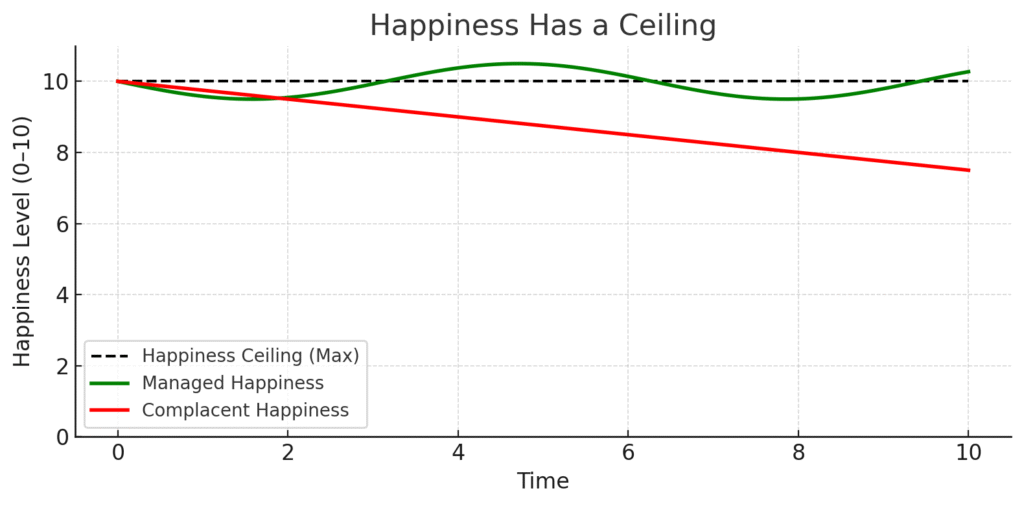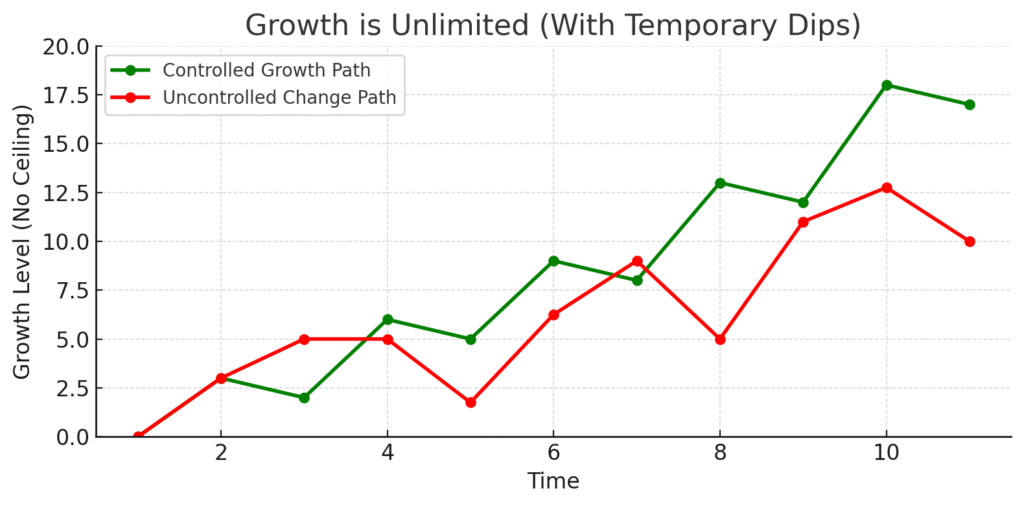Happiness Has a Ceiling
Happiness. The mythical Shangri-La we’re all supposedly striving for – the golden ticket, the endgame, the smug Instagram latte moment where life is perfect and you’ve “made it.” This is where the real debate of growth vs happiness begins – and why it matters more than we admit.
But here’s the thing: happiness has a ceiling. A cap. A built-in “no higher than this” sign. Zero is the pit of despair (hopefully you’re not there), ten is bliss, and once you’re at ten, that’s it. You can’t get more happy in that moment, no matter how many Labradors, beach holidays, or tax refunds you throw at it.
And here’s the dangerous bit: happiness is a trap. Stay there too long and you start mistaking comfort for fulfilment. Your edges dull, you become a domesticated house cat, and your happiness barometer quietly drops without you even noticing – like a slow tyre leak that only reveals itself when you’re stranded on the side of the road wondering why life feels flat.

Growth Has No Ceiling
That’s where growth comes in. The truth is, when it comes to growth vs happiness, you can have growth without happiness, but you can’t have happiness without growth. Stop growing and your happiness starts leaking out like air from a bouncy castle after the kids have gone home.
The thing about growth is it doesn’t have a ceiling. It’s infinite. You can keep building, learning, experimenting until the day you keel over – but it comes at a cost. Sometimes, to grow, you have to dent your own happiness on purpose.
Change careers. Learn to fly. Start a business. Learn the guitar when your brain and fingers have never really been on speaking terms. All of it takes time you’d normally spend on “happy things” – the pub on Friday, weekend lie-ins, binge-watching the same show for the third time – and money you could use for, I don’t know, keeping your house warm in winter.
But a little controlled unhappiness is infinitely better than the alternative: change smashing into you like a drunk uncle at a wedding.

The Trench: Where Resilience Lives
Choosing to climb into the trench – that uncomfortable in-between space between where you are and where you want to be – is understandably terrifying.
You’re scared you’ve left it too late.
Scared you won’t survive it.
Scared because you don’t know how long or deep it is.
Scared of how you’ll be perceived (“Sorry mate, can’t make beers, the budget’s on life support”).
But here’s the twist: the amount of happiness you’re willing to forgo is exactly what resilience is. Resilience isn’t just “bouncing back” – it’s your capacity to willingly take a hit now because you know what’s waiting on the other side. The deeper the trench you’re prepared to crawl through, the more resilience you’ve built. It’s not masochism; it’s a calculated trade-off.
If you don’t choose the trench, the trench will choose you – and when that happens, it’s worse. You feel like a victim. You get the anxiety, panic, dread, bitterness, and the kind of desperation that has you Googling “how to make a career in alpaca farming” at 2 a.m. It’s the reverse of the Stanford marshmallow test – act first and you get the two marshmallows. Wait, and you get one… dropped in the dirt… during a hailstorm.
Your Turn
So ask yourself – where’s your trench right now? Because when it comes to growth vs happiness, the choice is yours. Are you steering, or waiting for the crash?
Pick one thing you’re willing to trade a little happiness for – something that pushes you, challenges you, forces you to grow. Start today. Because you can have growth without happiness, but you’ll never have happiness without growth.
Not sure where you stand on all this? Take the quick Titanic Diagnostic. In just a few minutes, it’ll give you a clear view of whether you’re steering in the right direction – or just clinging to comfort and avoiding the uncomfortable work that actually drives growth.

No responses yet